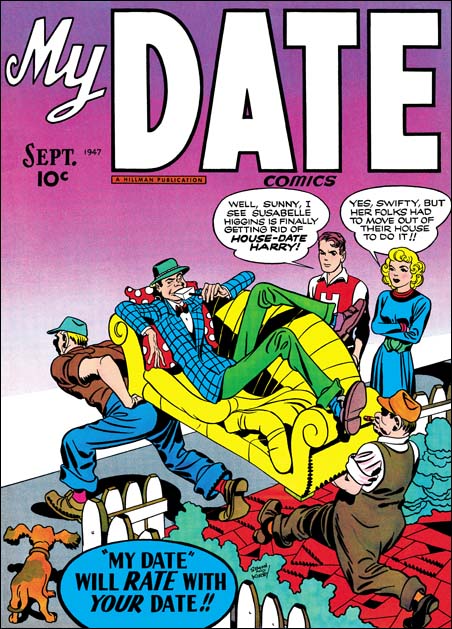
My Date #2 (September 1947) art by Jack Kirby
My Date was a short-lived comic that Simon and Kirby produced for Hillman Publications in 1947. Perhaps mislead by the comics title, some today hold the belief that My Date was the first romance comic book. As I discussed in a post on this topic (The First Romance Comic) it is not a romance comic at all but rather Simon and Kirby’s take on teenage humor modeled on the popular Archie comics. For his contributions to the title Jack Kirby drew in a more cartoonish manner appropriate for the humor content. Jack’s altered penciling was not very drastic, it remains quite easy to identify his work. For instance, Kirby trademarks such as his exaggerated perspective can be found in the covers and stories that Jack provided.

My Date #4 (January 1948) art by Jerry Robinson and Mort Meskin
All four My Date covers have traditionally been attributed to Jack Kirby, as for example by the Jack Kirby Checklist. I have long felt, and I am not alone in this, that the cover for My Date #4 was done by someone else. Gone are Jack’s exaggerated perspective, replaced by a relatively shallow depth of field viewed straight on. The drawing for My Date #4 is cartoonier then in the previous My Date covers. House-Date Harry looks rather different on issue #4 then on the covers for #2 and #3, or from their story art as well. The same is true for Swifty who also shows up on My Date #1 and #2 covers.
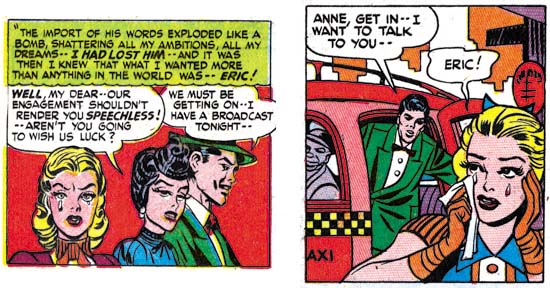
Young Romance #3 (January 1948) “Love or a Career” page 5 panel 5 and page 7 panel 4, art by Jerry Robinson and Mort Meskin
Readers of my last post on the inking of Mort Meskin may have spotted the long close and narrow brush marks that are used on the My Date #4 cover to indicate the folds of the clothing. Not all of Meskin inking traits that I previously described are found, but I am nonetheless certain that Mort was the inker. This a bit surprising because at this time Meskin was still producing work mainly for DC and his first signed work for S&K studio would not appear for months later. Young Romance #3 has the same cover date as My Date #4 and in it is the story “Love or a Career”. Unfortunately this story is unsigned but Meskin’s inking is once again quite apparent. I will explain my full attribution of this art below when I discuss the first signed works. The art for “Love or a Career” is the closest match to the MD #4 cover that I have been able to find. Consideration has to be given for the more cartoony style used for the teenage humor comic, but see how close the female character is in the two panels I have selected from YR #3 compared to Sunny of MD #4, similarly shaped face, arching eyebrows, eyes and lips.
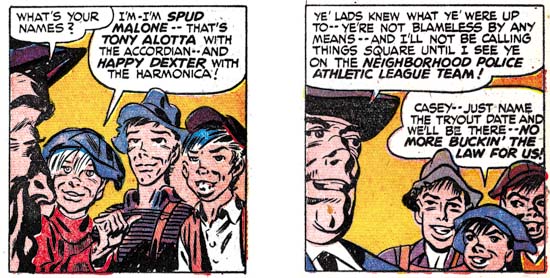
Justice Traps the Guilty #4 (May 1948) “Guilty Boys” page 1 panel 3 and page 5 panel 7, art by Jerry Robinson and Mort Meskin
Some months later art very similar to YR #3 appears in “Guilty Boys” from Justice Traps the Guilty #4. This is another unsigned piece with Meskin apparently doing the inking. This crime story was appropriately rendered more realistically then My Date #4 but similarities still show up. Note the comparable button noses of the boys to Swifty and to a lesser extent House-Date Harry on MD #4. The two boys on the right in the page 1 panel has a smiling cheek line similar to that of House-Date Harry.
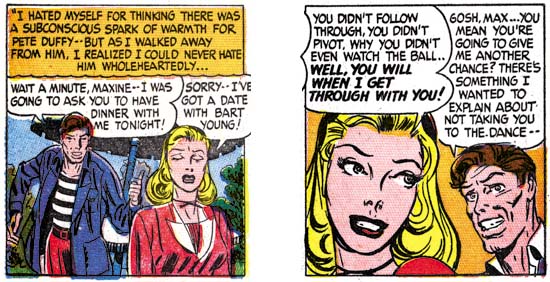
Young Romance #6 (July 1948) “The Inferior Male” page 7 panel 3 and page 8 panel 4, art by Jerry Robinson and Mort Meskin (signed)
Going forward two months provides two stories that bear the dual signatures of Jerry Robinson and Mort Meskin. The usual assumption is that the first signature designates the penciler and the second the inker. But I know nothing about how the Robinson and Meskin team worked so this may not be a safe assumption. Still it does look like Meskin’s inking while at least some of the figure drawing and compositions do not appear to be his. I have posted about “The Inferior Male” twice before (here and here). The correspondence between the art in YR #6 and that in YR #3 and JTTG #4 is close enough that the same artists were probably responsible for all. As seen in the above panels the female still looks like a more realistically drawn version of Sunny from the MD #4 cover.
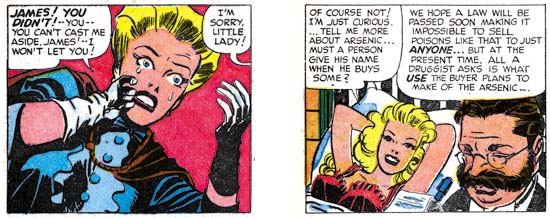
Justice Traps the Guilty #5 (July 1948)”Murder Special Delivery” page 3 panel 3 and page 4 panel 1, art by Jerry Robinson and Mort Meskin (signed)
Issue #5 of Justice Traps the Guilty also has the Robinson and Meskin signature. As might be expected there is great similarities with the YR #6 that came out in the same month. But this comparison is not perfect. In JTTG #5 the female leads start to take on the more stylized look that is typical of most of Meskin’s work for S&K. But the females have not adopted the more triangular face as done later by Mort so there still is a slight resemblance to Sunny from the MD #4 cover.
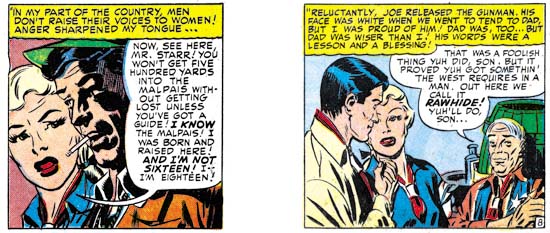
Real West Romances #5 (December 1949) “Tenderfoot In Love” page 2 panel 4 and page 8 panel 7 art by Mort Meskin (signed)
Mort Meskin would not show up again in S&K productions for over a year. By cover date of December 1949 things had clearly changed for Mort, the work would only be signed by him with no indication of any Robinson involvement. Meskin was no longer providing art for DC and this marks the start of a productive and consistent relationship with Simon and Kirby. In Real West Romances #5 the woman is drawn actually less stylized then found in the Robinson and Meskin’s piece in JTTG #5. Although not typical of Mort’s later work, the female in RWM #5 is not a very good match for that on My Date #4 either. This is largely due to the introduction of cheek bones that makes the face depart from the more simple geometry found on MD #4. Other similarities can still be found between the RWM #5 and MD #4, as for instance the old man’s eyebrows and smiling cheek line in the right panel as compared to House-Date Harry on MD #4.

Young Romance #16 (December 1949) “His Engagement Ring” page 1 splash, art by Mort Meskin (signed)
Meskin also appears during the same month in Young Romance #16. Once again Mort’s woman are not as stylized as they soon would be. but gone are the cheek bones that Mort provided woman in RWR #5. A resemblance to Sunny of MD #4 can still be seen, especially in the lady on the right of the above splash panel.
It may be a little surprising that a S&K production would have a cover drawn by an artist other then Jack Kirby. The only other non-Kirby covers were also done by Meskin along with Bill Draut, John Prentice and Ann Brewster. Those were all Prize romance covers with cover dates of 1954 and 1955, a period when Jack and Joe were busy with Mainline, their self owned publishing company. The reason Simon and Kirby made an exception for My Date #4 is most likely the same. A few months previously Simon and Kirby had launched Young Romance with Prize comics. As typical for them, most of the initial art for Young Romance was drawn by Jack. They had more recently lauched Justice Traps the Guilty. Not only was this all a lot of work for Kirby, it also was work for which S&K would have a share in the profits. Their deal with Hillman was not as good and so My Date #4 would be the last comic Simon and Kirby produced for that publisher with the exception of a single Western cover (Western Fighters #1, April 1948).


Harry,
Very well spotted. I completely agree with everything, even though I think the evidence showing that Robinson worked on My Date #4 as well is slight. But still, with what little there is to go on, it’s a reasonable guess. I believe anecdotal evidence shows that Meskin had some sort of nerveous breakdown around this time, which forced him to go into some sort of rest home. This is what broke up the Robinson/Meskin partnership. Have you got their joined title Atoman? Around the same time Meskin also shows up with a very poorly drawn (finished by someone else?) story in one of the later issues of Prize’s Treasure Comics. I believe it was #7.
Ger,
I wish I had more evidence for the Robinson involvement in My Date #4. Personally I think the connection I made is pretty good, but I wish I had examples of what Robinson and Meskin were doing for other publishers at this same period.
I am not familiear with either Atoman or Treasure #7. Once again you have pointed out things for me the check up on. Thanks.
Harry
I have been downloading some stuff from komics-live and came across some of those rarer books I’d never buy blindly. The Prize Tom Corbett books are there, as is Charlie Chan and some of Meskin’s earliest work for DC. There is no Atoman (which was from 1946), but I have those myself. Strangest thing about them is that Robinson and Meskin both worked solo in that title. From the same company came The Green Lama, whic is at Komics-live and has a solo Robinson story at least in #7 and 8. As for solo Meskin work from 1948 I have Western Comics #1-4, which have some of his last work for DC. Sadly, those are not scanned in… his listings at the GCD are not complete, but very interesting. He did Wildcat in Sensation? He worked on an issue of Whitchcraft? Frankenstein is there. As is a single Harvey horror story.
Ger,
Joe Simon’s collection includes the original art for that Harvey story, “Credit and Loss”. It is one of Mort’s better efforts.
Harry
This question of Meskin and Roussos keeps haunting me. There’s a great horror story up at http://thehorrorsofitall.blogspot.com/, which I would blindly assume was Roussos solo. But a poster there says it can’t be because of the crosshatching… the same crosshatching you identified as Meskin’s here and can be seen all through his Prize stuff. So either this is something Roussos picked up from Meskin or Meskin helped him imking. In both cases it seems to confirm me idea that they worked together all through the fifties and/or helped each other out.
Ger,
The link that you provide does not seem to get me there, but I believe you are refering to “The Frozen Death” story. My study of Roussos inking is not very thorough, but if you do not mind a preliminary opinion it looks like Roussos inking to me as well. The amount of crosshatching is surprising, but I do not believe it excludes Roussos, and I certainly do not believe it proves Meskin’s involvement. Crosshatching is a frequently used device, Meskin is by no means the only artist to use it. I feel one has to look at the rest of the inking as well and that does not look like Meskin to me at all.
Harry
Yes, it was The Frozen Death I was referring to. I accidentally added a / to the link. I agree that the most likely explenation is that Roussos borrowed the crosshatching trick from Mort Meskin. I know now where I picked up the idea that they worked together in the fifties. On the Roussos section of the Meskin websie it says Roussos worked for Crestwood in the fifties. That together with some remarks somewhere that Meskin only did the stories signed Mort solo made me think the others were inked by Roussos. I don’t have the time or the training to see inking styles as you do. Do you see any difference between signed and unisgned Meskin stories at Prize? Or does this just go for the work he did at DC (where he also did signed and unsigned stories and Roussos did solo work as well)?
Ger,
Roussos certainly worked for S&K, he did a couple of signed stories in 1952 and there may be some unsigned ones as well in that year. His style for those works has similarities to Meskin so I believe he learned some things from Mort.
Meskin was an extraordinary prolific artist. When I was preparing for my Meskin inking post I wanted to carefully review his work. But since there was so much of it I felt I did not have the time. So as part of my preparation I reexamined all the work Meskin did for Young Romance, a title he consistantly contributed to throughout his time with S&K. With one possible exception, all Meskin’s work looked like it was inked by one hand. Since I knew that Meskin actually worked in the S&K studio for at least part of this time, I concluded that inker was Meskin himself. That is not to say that Meskin’s work was consistant, some seemed sketchier, others seem more finished. My interpretation of this variation is that although Meskin was prolific, his art sometimes suffered from drive to produce a lot of work.
Are there differences between Mort’s signed and unsigned work? I did not notice any, but then again I was not specifically looking for it either. None of the artists who signed work that they did for S&K were consistant in doing so, so I did not have any reason to believe Mort was any different in this regard. But sometimes what you find is based on what you are looking for, so maybe the next time I review Mort’s work I will see something I failed to recognize before.
Harry